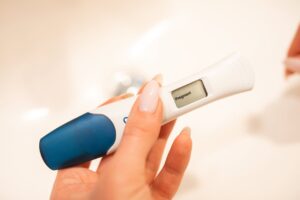
Mifepristone: The First Part of the Abortion Pill
Mifepristone is the first of two medications used in what is often referred to as the “abortion pill.” But what exactly is it, how does it work, and what should you know before taking it?
How Does Mifepristone Work?
Mifepristone is a drug that blocks the hormone progesterone, which is necessary for sustaining a pregnancy. Progesterone helps build the uterine lining that supports the growing embryo. Without it, the pregnancy cannot continue developing.
FDA Safety Guidelines
When the FDA approved mifepristone, specifically the brand Mifeprex, for medical abortion, they established safety guidelines. These include timing of use, certain medical conditions, and other factors that may increase risk.
It is not safe to take mifepristone if:
- More than 70 days have passed since your last menstrual period
- You have an ectopic pregnancy (pregnancy outside the uterus)
- You currently have an IUD in place
- You are taking blood thinners
These guidelines are designed to protect your health. Taking mifepristone outside of approved conditions can be ineffective and may increase the risk of serious complications.
Why Only in the First 70 Days?
Mifepristone is only approved for use within the first 70 days (10 weeks) of pregnancy. Beyond this point:
- The fetus is bigger, making the abortion less effective
- Risks of incomplete abortion and severe complications rise
- Effectiveness beyond this gestational age has not been well studied
If you are uncertain of when your last period was, an ultrasound can help determine the gestational age and in turn, how many weeks pregnant you are.
Why Doesn’t it Work for an Ectopic Pregnancy?
An ectopic pregnancy develops outside the uterus, usually in the fallopian tubes. Because mifepristone works by blocking progesterone in the uterus, it has no effect on an embryo developing elsewhere.
Ectopic pregnancies require urgent medical attention, typically involving surgery or other medications.
Why Does Having an IUD Matter?
An IUD (intrauterine device) can interfere with mifepristone’s effectiveness. Using mifepristone with an IUD in place increases the risk of a failed abortion and potential complications.
If you suspect that you are pregnant and have an IUD in place, always reach out to your health provider so that you can take the best course of action.
Is Mifepristone Effective If Taken Alone?
Mifepristone is only the first step in a medication abortion. The second medication, misoprostol, causes the uterus to contract and expel the pregnancy.
If only mifepristone is taken:
- The abortion is likely to be incomplete
- Risks of infection and hemorrhage increase
- Pregnancy may continue, sometimes with birth defects
What Side Effects Are There?
Like any medication, mifepristone has side effects, and these are important to know to make an informed decision. According to the labeling, the most commonly reported include:
- Nausea
- Weakness
- Fever/chills
- Vomiting
- Headache
- Diarrhea
- Dizziness
About one third to one half of women experience these side effects. Additionally, cramping and bleeding usually occur with a medical abortion.
Severe Risks and Black Box Warning
While rare, more serious reactions can occur, including:
- Severe bleeding or hemorrhage
- Sepsis & other infections
- Emergency room visits
- Hospitalization
- Blood transfusion
In fact, up to 1 in 25 women who take mifepristone require an ER visit.
The FDA has issued a black box warning, noting risks of “serious and sometimes fatal infections or bleeding.” Because of this, the FDA only approves one brand, Mifeprex, and its generic counterpart. They are available under a restricted distribution program. This ensures the proper quality and eliminates additional risks.
Because of these possible side effects, the FDA recommends a follow up 7-14 days after taking the misoprostol with your health provider.
Is Mifepristone Right For You?
Before deciding on a medication abortion, it’s important to understand:
- How far along you are (gestational age)
- Whether you may have an ectopic pregnancy
- What other health conditions or medications may affect safety
If you want more information about the process, need an ultrasound to confirm pregnancy details, or want to discuss all your options, schedule an appointment with us. We want you to be empowered with the right information so that you can make the best decision for yourself. You and only you can make this decision.
FAQs About Mifepristone
1. What is mifepristone used for?
Mifepristone is the first drug in a two-step medication abortion process. It blocks progesterone, stopping pregnancy growth.
2. Can mifepristone be taken alone?
No. Mifepristone must be followed by misoprostol for the abortion to be effective. Taking it alone increases the risk of failure and complications.
3. What are the most common side effects of mifepristone?
The most frequent side effects include nausea, cramping, bleeding, weakness, and fever.
4. Is mifepristone safe after 10 weeks of pregnancy?
Mifepristone is only FDA-approved for use up to 70 days (10 weeks). After that, risks and failure rates increase significantly.
5. Why does mifepristone have a black box warning?
Because of the risk of severe infections and bleeding that are potentially life-threatening, the FDA requires a black box warning.
References
Mifeprex Labeling: https://www.accessdata.fda.gov/drugsatfda_docs/label/2023/020687Orig1s025Lbl.pdf
Questions and Answers on Mifepristone for Medical Termination of Pregnancy Through Ten Weeks Gestation: https://www.fda.gov/drugs/postmarket-drug-safety-information-patients-and-providers/questions-and-answers-mifepristone-medical-termination-pregnancy-through-ten-weeks-gestation
Recent Stories

Missed Period Pills: Understanding the Risks and Realities
Read Article
Is Having an Abortion Like Having Your Period?
Read Article
Salt Pregnancy Test: What It Is, How It Works, and If It’s Accurate
Read Article
Mifepristone: The First Part of the Abortion Pill
Read Article
